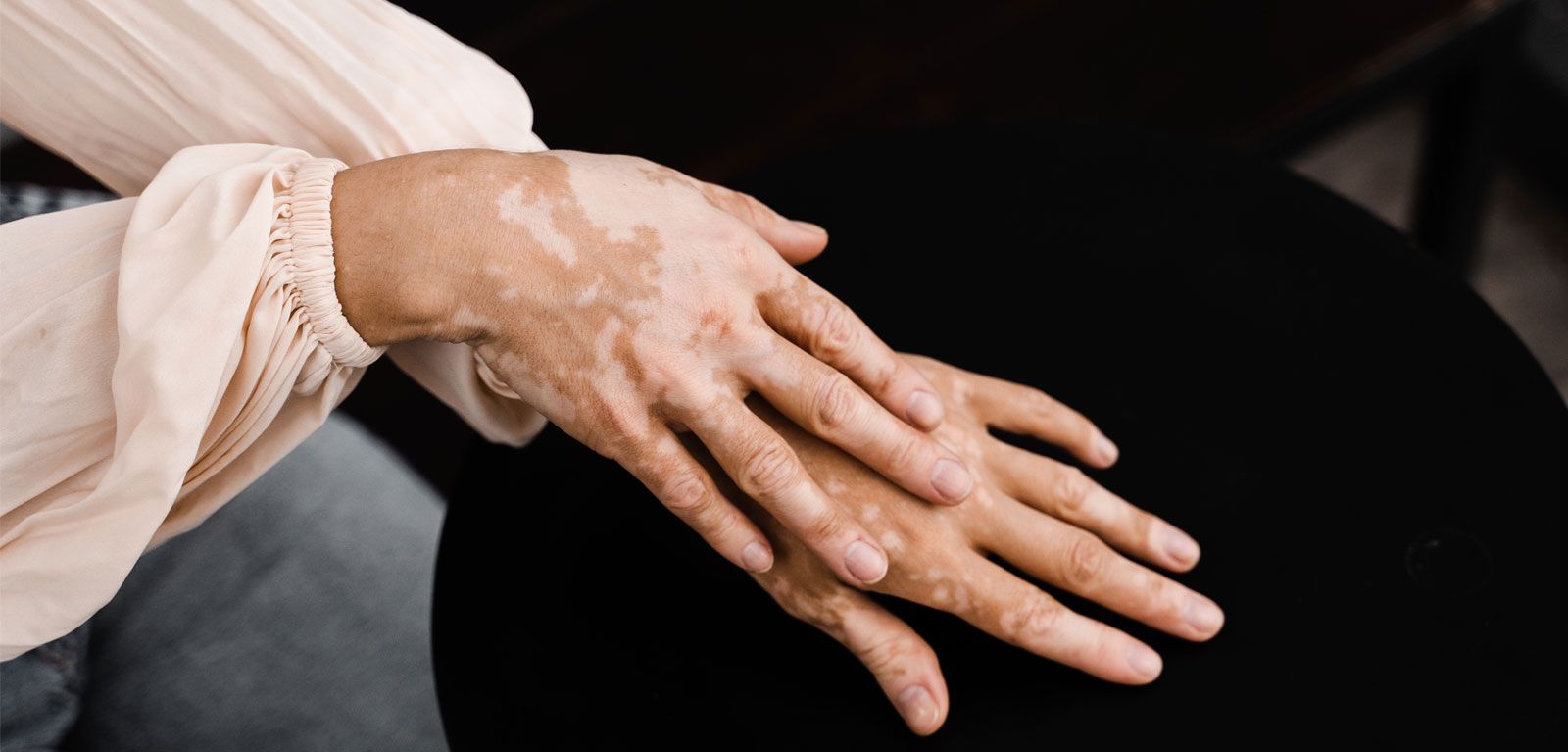Vitiligo.

Overview
Vitiligo is a condition in which skin loses its color, resulting in lighter patches and spots. It’s caused by the loss of pigment-producing cells (melanocytes). This condition can affect skin, hair, and inside of mouth, appearing as white patches. Vitiligo can enlarge over time, causing cosmetic distress, particularly in people with dark skin.
Cause
The exact cause of vitiligo is still unknown. Normally, the color of hair and skin is determined by melanin. Vitiligo
occurs when cells that produce melanin die or stop functioning.
It may be related to:
It may be related to:
- A disorder of the immune system (autoimmune condition)
- Family history (heredity)
- A trigger event, such as stress, severe sunburn or skin trauma, such as contact with a chemical
- oxidative stress or viral causes.
Symptoms
- Light patches on the skin
- Premature whitening of hair on scalp, eyelashes, eyebrows, or beard
- Loss of color in mucous membranes, such as inside the mouth and nose
- Patches may stay the same size or grow larger over time
- New patches may be close to or far from existing patches.
Types of Vitiligo
Universal vitiligo: affects nearly all skin surfaces
Generalized vitiligo: affects many parts of the body
Segmental vitiligo: affects only one side or part of the body
Localized (focal) vitiligo: affects one or only a few areas of the body
Acrofacial vitiligo: affects the face and hands.
Generalized vitiligo: affects many parts of the body
Segmental vitiligo: affects only one side or part of the body
Localized (focal) vitiligo: affects one or only a few areas of the body
Acrofacial vitiligo: affects the face and hands.
Treatments
There is no cure for vitiligo and treatment is often unsatisfactory. The aim is to stop progression of the disease and to
achieve satisfactory re-pigmentation.
Treatment options
Topical
- Ointment
- Cream
Systemic therapy
- Light based: PUVA and NB-UVB phototherapy to the whole body and targeted phototherapy by UVB laser, Excimer laser and Excimer lamp.
Surgical
Vitiligo surgery is recommended for areas which are cosmetically disfiguring and resistant to medical treatment. Vitiligo surgery aims at restoration of normal pigmented skin through surgical means, which can be:
- Complete skin transfers: by suction blister grafting / punch grafting.
- Cell transplantations: cultured melanocyte suspension transplant and non-cultured melanocyte suspension transplant. LA-PEEST or laser assisted PRP enriched epidermal suspension transplant.
- Non-cultured melanocyte-keratinocyte cell suspension transplantation
- Split skin grafting
- Cultured autografts of melanocytes grown in tissue culture.
Depigmentation therapy
Cryotherapy and laser treatment
Home care / DIY care
-
Protect skin from cuts, scratches or grazes to prevent spread of the disease.
-
Use sun protection measures, such as wearing SPF 45 sunscreen, protective clothing and hats.
-
Avoid exposure to midday sun (10AM to 3PM) and tanning.
FAQs
Is vitiligo at all contagious?
Vitiligo is not contagious. It is a genetic disease, caused by inheritance of multiple causal genes simultaneously,
possibly in different combinations in different people, plus exposure to environmental risk factors that remain mostly
unknown.
What is the fastest way to cure vitiligo?
No drug can stop the process of vitiligo. But some drugs, used alone, in combination or with light therapy, can help
restore some color.If you have vitiligo, the sooner vitiligo treatment starts, the more effective it tends to be. Left
untreated for years, vitiligo may be difficult to treat.You may expect satisfactory results within 12-18 months
Can you prevent vitiligo?
There is currently no way to prevent vitiligo. If you see light-colored spots or patches on your skin, visit a
dermatologist.
Will the vitiligo patches spread over time and Will they get larger?
In many, but certainly not all cases, vitiligo does progress slowly over time, but there is really no way to tell whether
your vitiligo will progress or not. It is a slow progressing condition however, and many patients report that they may
go many years without new patches developing, and then may discover new patches appearing years later. Some
people even report spots that spontaneously repigment, with no treatment at all. Use of new technologies however,
may be able to arrest new spots in their development.
What types of Vitiligo patches are treatable?
The patches which are stable and not spreading for past 3 months are treatable. Even the large areas of white
patches can be treated at all body parts including delicate areas like upper eyelids, under arms and groins.
best natural results
Elara has expertise in technological advances & their suitability, and adaptability to different subjects.
We strive to treat our patients with high quality affordable & excellent Skin and laser treatments. You will get that natural touch of treatment that you will hardly get anywhere with us.
We strive to treat our patients with high quality affordable & excellent Skin and laser treatments. You will get that natural touch of treatment that you will hardly get anywhere with us.
